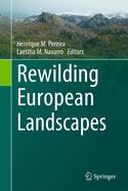Explore

Rewilding European Landscapes
Some European lands have been progressively alleviated of human pressures, particularly traditional agriculture in remote areas. This book proposes that this land abandonment can be seen as an opportunity to restore natural ecosystems via rewilding. We define rewilding as the passive management of ecological successions having in mind the long-term goal of restoring natural ecosystem processes. The book aims at introducing the concept of rewilding to scientists, students and practitioners. The first part presents the theory of rewilding in the European context. The second part of the book directly addresses the link between rewilding, biodiversity, and habitats. The third and last part is dedicated to practical aspects of the implementation of rewilding as a land management option. We believe that this book will both set the basis for future research on rewilding and help practitioners think about how rewilding can take place in areas under their management.
This book is included in DOAB.
Why read this book? Have your say.
You must be logged in to comment.
Rights Information
Are you the author or publisher of this work? If so, you can claim it as yours by registering as an Unglue.it rights holder.Downloads
- 155 - pdf (CC BY-NC) at OAPEN Library.
- 141 - mobi (CC BY-NC) at Unglue.it.
- 154 - pdf (CC BY-NC) at Unglue.it.
- 194 - epub (CC BY-NC) at Unglue.it.
Keywords
- conservation
- ecology
- landscape
- Applied ecology
- Biodiversity
- Biology, Life Sciences
- Ecological science, the Biosphere
- Economics
- Economics, finance, business & management
- Ecosystem services
- Environmental economics
- Environmental management
- Land management
- Landscape ecology
- Life sciences: general issues
- Mathematics & science
- Nature conservation
- Restoration ecology
- Rewilding
- thema EDItEUR::K Economics, Finance, Business and Management::KC Economics::KCV Economics of specific sectors::KCVG Environmental economics
- thema EDItEUR::P Mathematics and Science::PS Biology, life sciences::PSA Life sciences: general issues::PSAF Ecological science, the Biosphere
Links
DOI: 10.1007/978-3-319-12039-3web: https://link.springer.com/book/10.1007/978-3-319-12039-3
Editions

